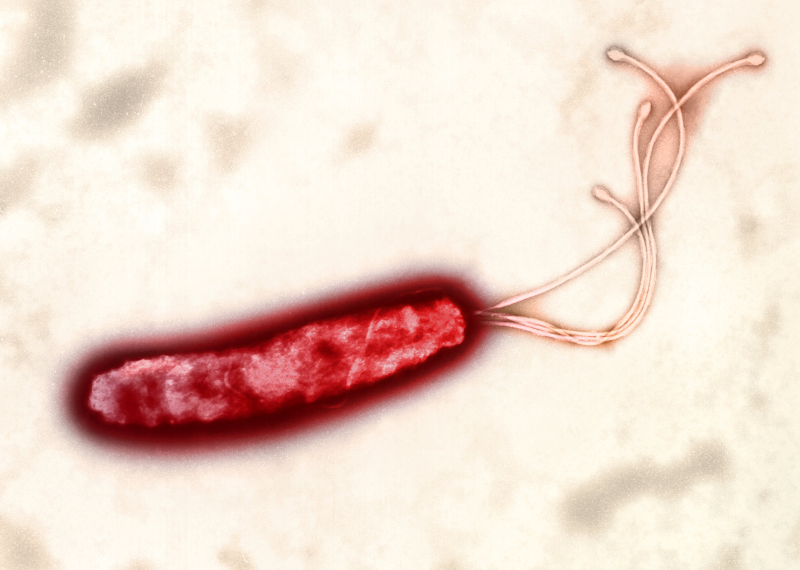Summary
Definition
History and exam
Key diagnostic factors
- dor abdominal
- presença de fatores de risco
- "sinal de apontar"
Other diagnostic factors
- desconforto epigástrico
- náuseas ou vômitos
- saciedade precoce
- perda de peso ou anorexia
- diarreia
- sintomas de anemia
- hemorragia digestiva
- hipotensão ou choque séptico
- som de sucussão
Risk factors
- infecção por Helicobacter pylori
- uso de anti-inflamatórios não esteroidais (AINEs)
- tabagismo
- idade mais avançada
- história pessoal de úlcera péptica
- história familiar de úlcera péptica
- paciente de terapia intensiva
- trabalho por turnos
Diagnostic tests
1st tests to order
- endoscopia digestiva alta
- Teste respiratório de ureia com carbono 13 para Helicobacter pylori ou teste de antígeno fecal
- Hemograma completo
Tests to consider
- nível de gastrina sérica em jejum
- exame de AINE na urina
Algoritmo de tratamiento
úlcera com sangramento ativo
sem sangramento ativo: Helicobacter pylori negativo
sem sangramento ativo: Helicobacter pylori positivo
úlceras recorrentes ou refratárias
Colaboradores
Consejeros especializados
Ian Beales, BSc, MD, FRCP, FEBG
Consultant Gastroenterologist
Clinical Associate Professor
Norwich Medical School
Department of Gastroenterology
Norfolk and Norwich University Hospital
Norwich
UK
Divulgaciones
IB declares that he has no competing interests.
Agradecimientos
BMJ Best Practice would like to gratefully acknowledge the previous expert contributor, whose work has been retained in parts of the content:
Kristle Lee Lynch, MD
Assistant Professor of Clinical Medicine
Division of Gastroenterology
Department of Medicine
Hospital of the University of Pennsylvania
University of Pennsylvania
Perelman School of Medicine
Philadelphia
PA
Divulgaciones
KLL declares that she has no competing interests.
Revisores por pares
Alexander C Ford, MBChB, MD, FRCP
Professor of Gastroenterology
Honorary Consultant Gastroenterologist
Leeds Institute of Medical Research at St. James's
University of Leeds
Leeds Gastroenterology Institute
Leeds Teaching Hospitals Trust
Leeds
UK
Biografía
ACF served on the National Institute for Health and Care Excellence (NICE) guideline committee for clinical guideline CG184: Gastro-oesophageal reflux disease and dyspepsia in adults: investigation and management.
Divulgaciones
ACF declares that he has no competing interests. ACF is an author of a Cochrane systematic review cited in this topic.
Agradecimiento de los revisores por pares
Los temas de BMJ Best Practice se actualizan de forma continua de acuerdo con los desarrollos en la evidencia y en las guías. Los revisores por pares listados aquí han revisado el contenido al menos una vez durante la historia del tema.
Divulgaciones
Las afiliaciones y divulgaciones de los revisores por pares se refieren al momento de la revisión.
Referencias
Artículos principales
National Institute for Health and Care Excellence. Gastro-oesophageal reflux disease and dyspepsia in adults: investigation and management. Oct 2019 [internet publication].Texto completo
UK Health Security Agency. Helicobacter pylori in dyspepsia: test and treat. Jan 2025 [internet publication].Texto completo
Moayyedi PM, Lacy BE, Andrews CN, et al. ACG and CAG clinical guideline: management of dyspepsia. Am J Gastroenterol. 2017 Jul;112(7):988-1013.Texto completo Resumen
National Institute for Health and Care Excellence. Acute upper gastrointestinal bleeding in over 16s: management. August 2016 [internet publication].Texto completo
Siau K, Hearnshaw S, Stanley AJ, et al. British Society of Gastroenterology (BSG)-led multisociety consensus care bundle for the early clinical management of acute upper gastrointestinal bleeding. Frontline Gastroenterol. 2020;11(4):311-23.Texto completo Resumen
Artículos de referencia
Una lista completa de las fuentes a las que se hace referencia en este tema está disponible para los usuarios con acceso a todo BMJ Best Practice.

Diferenciales
- Câncer esofágico
- Câncer de estômago
- Doença do refluxo gastroesofágico (DRGE)
Más DiferencialesGuías de práctica clínica
- Gastro-oesophageal reflux disease and dyspepsia in adults: investigation and management
- Acute upper gastrointestinal bleeding in over 16s: management
Más Guías de práctica clínicaCalculadoras
Escore de Blatchford para sangramento gastrointestinal
Escore de Rockall para hemorragia digestiva alta
Más CalculadorasFolletos para el paciente
Úlceras pépticas
Más Folletos para el pacienteInicie sesión o suscríbase para acceder a todo el BMJ Best Practice
El uso de este contenido está sujeto a nuestra cláusula de exención de responsabilidad